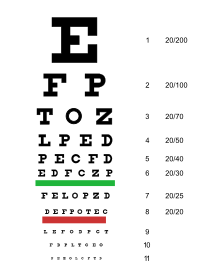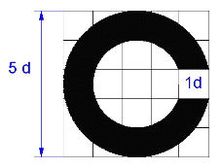Optotypes

Chart symbols , also called optotypes , are letters , numbers , images or symbols that are used to determine visual acuity. The line width (1/5 of the type size) of the optotypes is measured in such a way that it appears to the eye at an angle of 1 arc minute in the row intended for visual acuity 1 . The Landolt ring is a standardized DIN symbol . Other optotypes are the Snellen hook , which is often used for examining children, and the eye test charts . In addition, when examining near vision, a text table with running text in different font sizes is often used, for example the so-called Nieden reading samples.
Single and series optotypes
Optotypes that are close to one another are less easy to recognize because closely adjacent contours impair the resolution, which leads to so-called separation difficulties or crowding. With series optotypes, this can result in a deterioration of up to one visus level. In the case of amblyopia , nystagmus or insufficiently corrected ametropia , the differences between series and individual optotypes can even have very significant effects. With Landolt rings, a minimum distance of the optotypes from one another is prescribed from a visual acuity of 0.32 and for all larger optotypes, which should be greater than 35 angular minutes. This distance is outside the zone of contour interactions. With smaller optotypes from a visual acuity of 0.4, however, only twice the diameter of the Landolt ring is required as the distance between the optotypes. This puts them in the interaction zone. For this reason, special tests with Landolt rings (C-test) have been developed for clinical investigations, which clearly distinguish between individual and series optotypes. In the case of the individual optotypes, all optotypes are at least 35 angular minutes away from each other through all visual levels. In the case of the series optotypes, the distance through all visus levels is exactly 2.6 angular minutes. The test distance is 40 cm in both cases.
Web links
- DIN EN ISO 10938: Ophthalmic instruments - chart projectors . DIN NA 027, Precision Mechanics and Optics Standards Committee (NAFuO)
literature
- Herbert Kaufmann: Strabismus . 3rd fundamentally revised and expanded edition, with the collaboration of W. de Decker u. a. Georg Thieme Verlag, Stuttgart / New York 2003, ISBN 3-13-129723-9

